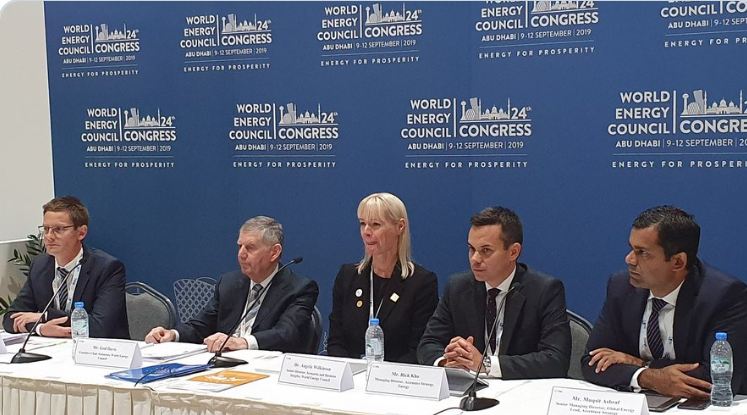WEC 24: What global energy experts say on hazardous solar waste at 24th WEC 2019
As climate change is nearing reality, the pressure and allurement for a transition from fuel energy to clean energy is mounting day by day. The solar energy is obviously the choice of many to evade the threat of climate change but even greater is the imminent threat of flooding the world with a huge environmental burden of solar waste. Devdiscourse asked global experts on hazardous solar waste in a press conference at the 24th World Energy Congress, 2019 in Abu Dhabi.

- Country:
- United Arab Emirates
The global energy leaders from over 150 countries of the world are gathered in World Energy Congress 2019 to discuss various aspects of the energy sector from technology to policy to new scenarios to clean energy and much more.
On the first day of the four days WEC24 in Abu Dhabi, the World Energy Council - the largest network of energy leaders dedicated to delivering a sustainable energy system for the greatest benefit of all - released a report on global energy scenario on September 9, 2019 in Hall Number 10, Abu Dhabi Exhibition Center, Abu Dhabi, UAE. The report was prepared by the World Energy Council in association with Accenture Strategy, Ireland and the Paul Scherrer Institute, Switzerland.
Devdiscourse raised the question of hazardous solar waste that has caused a huge challenge before solar energy technology.
In their reply, the experts unanimously accepted that there is no single technology for clean energy and the world needs multiple technologies for an energy transition from hydrocarbon to clean energy. They emphasized the need for better technological innovations on clean energy. To see the full video, click here:
In fact, today, the solar power energy market is driven by silos wherein the vision of various stakeholders is confined to their respective interests. The countries producing and exporting solar power panels are least concerned with environmental hazards in the consumer countries while the consumer countries are not much concerned about the requirement of resources and environmental damage and are inviting the manufacturing companies to install industrial units. These perspectives may provide an immediate solution to the energy crisis for a nation or group of nations but definitely retrogressive for the world in the long term if we want to achieve the global goals set up by the United Nations for 2030.
According to the estimates of the International Renewable Energy Agency (IRENA), the planet had a load of 250,000 metric tonnes of solar panel waste in 2016 which is projected to reach 78 million metric tonnes by 2050. These estimates alone are sufficient to burst the balloon of solar energy as the super inventions for the Clean and Affordable Energy.
The amount of solar waste on the planet due to solar energy could be assessed with the example of Nigeria. As around 60% of Nigeria's population has no access to electricity the country has decided to install 30,000 MW of solar PV by 2030. According to an estimate for 30,000 MW, about 40 million batteries will be required. The typical lifetime of a battery is about three years compared to 20-25 years' average lifespan of the PV panels. It roughly means 280 million batteries will have to be installed, replaced, recovered and then required to be recycled in the whole lifetime of PV panels that themselves would add to the solar waste after 20-25 years.
Amy Yee in an article in the New York Times titled Electronic Marvels turn into dangerous trash in East Africa has described the dangerous level of all forms of pollution and health hazards caused by used PV panels and accessory instruments. A study by Bridge to India (BTI) reveals that India's PV waste volume would become 200,000 tonnes by 2030 and around 1.8 million tonnes by 2050. The situation is other developing countries and regions are equally grim.
For more news, views, and interview, please visit Live Discourse.
(Siddheshwar Shukla and Neeraj Singh Mehta, Team Devdiscourse from Abu Dhabi)
- FIRST PUBLISHED IN:
- Devdiscourse

 Siddheshwar Shukla
Siddheshwar Shukla









